Concrete degradation
Concrete degradation may have various causes. Concrete can be damaged by fire, aggregate expansion, sea water effects, bacterial corrosion, calcium leaching, physical damage and chemical damage (from carbonatation, chlorides, sulfates and non-distilled water). This process adversely affects concrete exposed to these damaging stimuli.
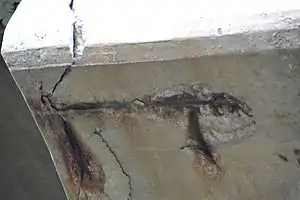
Aggregate expansion
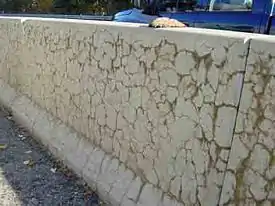
Various types of aggregate undergo chemical reactions in concrete, leading to damaging expansive phenomena. The most common are those containing reactive silica, that can react (in the presence of water) with the alkalis in concrete (K2O and Na2O, coming principally from cement). Among the more reactive mineral components of some aggregates are opal, chalcedony, flint and strained quartz. Following the alkali-silica reaction (ASR), an expansive gel forms, that creates extensive cracks and damage on structural members. On the surface of concrete pavements the ASR can cause pop-outs, i.e. the expulsion of small cones (up to 3 cm (1 in) in diameter), corresponding to aggregate particle size.
When some aggregates containing dolomite are used, a dedolomitization reaction occurs where the magnesium carbonate compound reacts with hydroxyl ions and yields magnesium hydroxide and a carbonate ion. The resulting expansion may cause destruction of the material. Far less common are pop-outs caused by the presence of pyrite, an iron sulfide that generates expansion by forming iron oxide and ettringite. Other reactions and recrystallizations, e.g. hydration of clay minerals in some aggregates, may lead to destructive expansion as well.
Corrosion of reinforcement bars
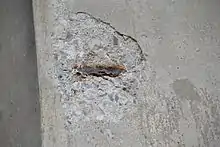
The expansion of the corrosion products (iron oxides) of carbon steel reinforcement structures may induce mechanical stress that can cause the formation of cracks and disrupt the concrete structure. If rebars have been improperly installed or have inadequate concrete cover at surfaces exposed to the elements, oxide jacking and spalling can occur during the structure's lifetime: flat fragments of concrete are detached from the concrete mass as a result of the rebar's corrosion.
Chemical damage
Alkali–silica reaction (ASR)
The alkali–silica reaction (ASR) is a deleterious chemical reaction between the alkali (Na
2O and K
2O, in fact dissolved NaOH and KOH) of the cement paste with reactive amorphous (non-crystalline) siliceous aggregates in the presence of moisture. This reaction produces a gel-like substance of sodium silicate (Na
2SiO
3 • n H
2O), also noted Na
2H
2SiO
4 • n H
2O, or N-S-H (sodium silicate hydrate). This hygroscopic gel swells inside the affected reactive aggregates which expand and crack. In its turn, it causes concrete expansion. If concrete is heavily reinforced, it can first cause some prestressing effect before cracking and damaging the structure.
Carbonation

Carbon dioxide from air can react with the calcium hydroxide in concrete to form calcium carbonate. This process is called carbonation, which is essentially the reversal of the chemical process of calcination of lime taking place in a cement kiln. Carbonation of concrete is a slow and continuous process progressing from the outer surface inward, but slows down with increasing diffusion depth.[1]
Carbonation has two effects: it increases mechanical strength of concrete, but it also decreases alkalinity, which is essential for corrosion prevention of the reinforcement steel.[1] Below a pH of 10, the steel's thin layer of surface passivation dissolves and corrosion is promoted. For the latter reason, carbonation is an unwanted process in concrete chemistry. It can be tested by applying phenolphthalein solution, a pH indicator, over a fresh fracture surface, which indicates non-carbonated and thus alkaline areas with a violet color.[2][3]
Chloride attack
The main effect of chloride anions on reinforced concrete is to cause pitting corrosion of the steel reinforcement bars (rebar). It is a surreptitious and dangerous form of localized corrosion because the rebar sections can be decreased to the point that the steel reinforcement are no longer capable to withstand to the tensile efforts they are supposed to resist by design. When the rebar sections are too small or the rebar are locally broken, the reinforcements are lost and concrete is no longer reinforced concrete.
Chlorides, particularly calcium chloride, have been used to shorten the setting time of concrete.[4] However, calcium chloride and (to a lesser extent) sodium chloride have been shown to leach calcium hydroxide and cause chemical changes in Portland cement, leading to loss of strength,[5] as well as attacking the steel reinforcement present in most concrete. The ten-storey Queen Elizabeth hospital in Kota Kinabalu contained a high percentage of chloride causing early failure.
External sulfate attacks (ESA)
Sulfates in solution in contact with concrete can cause chemical changes to the cement, which can cause significant microstructural effects leading to the weakening of the cement binder (chemical sulfate attack). Sulfate solutions can also cause damage to porous cementitious materials through crystallization and recrystallization (salt attack).[6] Sulfates and sulfites are ubiquitous in the natural environment and are present from many sources, including gypsum (calcium sulfate) often present as an additive in 'blended' cements which include fly ash and other sources of sulfate. With the notable exception of barium sulfate, most sulfates are slightly to highly soluble in water. These include acid rain where sulfur dioxide in the airshed is dissolved in rainfall to produce sulfurous acid. In lightning storms, the dioxide is oxidised to trioxide making the residual sulfuric acid in rainfall even more highly acidic. Local government infrastructure is most commonly corroded by sulfate arising from the oxidation of sulfide which occurs when bacteria (for example in sewer mains) reduce the ever-present hydrogen sulfide gas to a film of sulfide (S-) or bi-sulfide (HS-) ions. This reaction is reversible, both readily oxidising on exposure to air or oxygenated stormwater, to produce sulfite or sulfate ions and acidic hydrogen ions in the reaction HS− + H2O+ O2 -> 2H+ + SO4-. The corrosion often present in the crown (top) of concrete sewers is directly attributable to this process - known as crown rot corrosion.[7]
Delayed ettringite formation (DEF)
When the temperature of concrete exceeds 65 °C during a too long time at the early age, the crystallization of ettringite (AFt) does not occur because of its higher solubility at elevated temperature and the then less soluble mono-sulfate (AFm) is formed. After dissipation of the cement hydration heat, temperature goes back to ambient and the temperature curves of the solubilities of AFt and AFm phases cross over. The mono-sulfate (AFm) now more soluble at low temperature slowly dissolves to recrystallize as the less soluble ettringite (AFt). AFt crystal structure hosts more water molecules than AFm. So, AFt has a higher molar volume than AFm because of its 32 H2O molecules. During months, or years, after young concrete cooling, AFt crystallizes very slowly as small acicular needles and can exert a considerable crystallization pressure on the surrounding hardened cement paste (HCP). This leads to the expansion of concrete, to its cracking, and it can ultimately lead to the ruin of the affected structure. The characteristic feature of delayed ettringite formation (DEF) is a random honeycomb cracking similar to this of the alkali-silica reaction (ASR). In fact this crack pattern is common to all expansive internal reactions or to hindered shrinkage. DEF is also known as internal sulfate attack (ISA). External sulfate attack (ESA) also involves ettringite (AFt) formation and deleterious expansion with the same harmful symptoms but requires an external source of sulfate anions in the surrounding terrains or environment. To avoid DEF or ISA reactions, the best way is to use a low C3A (tri-calcium aluminate) cement precluding the formation of ettringite (AFt). Sulfate resisting (SR) cements have also a low content in Al2O3.
Calcium leaching
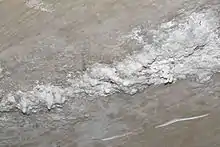
When water flows through cracks present in concrete, water may dissolve various minerals present in the hardened cement paste or in the aggregates, if the solution is unsaturated with respect to them. Dissolved ions, such as calcium (Ca2+), are leached out and transported in solution some distance. If the physico-chemical conditions prevailing in the seeping water evolve with distance along the water path and water becomes supersaturated with respect to certain minerals, they can further precipitate, making calthemite deposits (predominately calcium carbonate) inside the cracks, or at the concrete outer surface. This process can cause the self-healing of fractures in particular conditions.
Fagerlund [8](2000) determined that, “About 15% of the lime has to be dissolved before strength is affected. This corresponds to about 10% of the cement weight, or almost all of the initially formed Ca(OH)2.” Therefore a large amount of "calcium hydroxide" (Ca(OH)2) must be leached from the concrete before structural integrity is affected. The other issue however is that leaching away Ca(OH)2 may allow the corrosion of reinforcing steel to affect structural integrity.
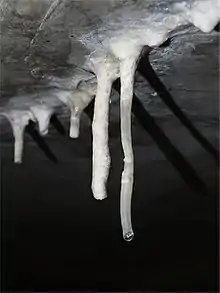
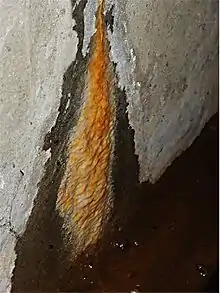
Decalcification
Within set concrete there remains some free "calcium hydroxide" (Ca(OH)2),[1] which can further dissociate to form Ca2+ and hydroxide (OH−) ions".[9] Any water which finds a seepage path through micro cracks and air voids present in concrete, will readily carry the (Ca(OH)2) and Ca2+ (depending on solution pH and chemical reaction at the time) to the underside of the structure where leachate solution contacts the atmosphere.[10] Carbon dioxide (CO2) from the atmosphere readily diffuses into the leachate and causes a chemical reaction, which precipitates (deposits) calcium carbonate (CaCO3) on the outside of the concrete structure. Consisting primarily of CaCO3 this secondary deposit derived from concrete is known as "calthemite"[10] and can mimic the shapes and forms of cave "speleothems", such as stalactites, stalagmites, flowstone etc.[11] Other trace elements such as iron from rusting reinforcing may be transported and deposited by the leachate at the same time as the CaCO3. This may colour the calthemites orange or red.[12]
The chemistry involving leaching of calcium hydroxide from concrete can facilitate the growth of calthemites up to ≈200 times faster than cave speleothems due to the different chemical reactions involved.[13] The sight of calthemite is a visual sign that calcium is being leached from the concrete structure and the concrete is gradually degrading.[10][14]
In very old concrete where the calcium hydroxide has been leached from the leachate seepage path, the chemistry may revert to that similar to "speleothem" chemistry in limestone cave.[10][11] This is where carbon dioxide enriched rain or seepage water forms a weak carbonic acid, which leaches calcium carbonate (CaCO3) from within the concrete structure and carries it to the underside of the structure.[15] When it contacts the atmosphere, carbon dioxide degasses and calcium carbonate is precipitated to create calthemite deposits,[10] which mimic the shapes and forms of speleothems.[11] This degassing chemistry is not common in concrete structures as the leachate can often find new paths through the concrete to access free calcium hydroxide and this reverts the chemistry to that previously mentioned where CO2 is the reactant.[10]
Sea water

Concrete exposed to seawater is susceptible to its corrosive effects. The effects are more pronounced above the tidal zone than where the concrete is permanently submerged. In the submerged zone, magnesium and hydrogen carbonate ions precipitate a layer of brucite, about 30 micrometers thick, on which a slower deposition of calcium carbonate as aragonite occurs. These layers somewhat protect the concrete from other processes, which include attack by magnesium, chloride and sulfate ions and carbonatation. Above the water surface, mechanical damage may occur by erosion by waves themselves or sand and gravel they carry, and by crystallization of salts from water soaking into the concrete pores and then drying up. Pozzolanic cements and cements using more than 60% of slag as aggregate are more resistant to sea water than pure Portland cement. Sea water corrosion contains elements of both chloride and sulfate corrosion.
Bacterial corrosion
Bacteria themselves do not have noticeable effect on concrete. However, sulfate-reducing bacteria in untreated sewage tend to produce hydrogen sulfide, which is then oxidized by aerobic bacteria present in biofilm on the concrete surface above the water level to sulfuric acid. The sulfuric acid dissolves the carbonates in the cured cement and causes strength loss, as well as producing sulfates which are harmful to concrete. Concrete floors lying on ground that contains pyrite (iron(II) sulfide) are also at risk. As a preventive measure sewage may be pretreated to increase pH or oxidize or precipitate the sulfides in order to inhibit the activity of sulfide utilizing bacteria.
Physical damage
Damage can occur during the casting and de-shuttering processes. For instance, the corners of beams can be damaged during the removal of shuttering because they are less effectively compacted by means of vibration (improved by using form-vibrators). Other physical damage can be caused by the use of steel shuttering without base plates. The steel shuttering pinches the top surface of a concrete slab due to the weight of the next slab being constructed.
Concrete slabs, block walls and pipelines are susceptible to cracking during ground settlement, seismic tremors or other sources of vibration, and also from expansion and contraction during adverse temperature changes.
Thermal damage
Due to its low thermal conductivity, a layer of concrete is frequently used for fireproofing of steel structures. However, concrete itself may be damaged by fire. An example of this was the 1996 Channel fire, where the fire reduced the thickness of concrete in an undersea tunnel connecting France with England. For this reason, common fire testing standards, such as ASTM E119,[16] do not permit fire testing of cementitious products unless the relative humidity inside the cementitious product is at or below 75%. Otherwise, concrete can be subject to significant spalling.
Up to about 300 °C, the concrete undergoes normal thermal expansion. Above that temperature, shrinkage occurs due to water loss; however, the aggregate continues expanding, which causes internal stresses. Up to about 500 °C, the major structural changes are carbonatation and coarsening of pores. At 573 °C, quartz undergoes rapid expansion due to phase transition, and at 900 °C calcite starts shrinking due to decomposition. At 450-550 °C the cement hydrate decomposes, yielding calcium oxide. Calcium carbonate decomposes at about 600 °C. Rehydration of the calcium oxide on cooling of the structure causes expansion, which can cause damage to material which withstood fire without falling apart. Concrete in buildings that experienced a fire and were left standing for several years shows extensive degree of carbonatation from carbon dioxide which is reabsorbed.
Concrete exposed to up to 100 °C is normally considered as healthy. The parts of a concrete structure that is exposed to temperatures above approximately 300 °C (dependent of water/cement ratio) will most likely get a pink color. Over approximately 600 °C the concrete will turn light grey, and over approximately 1000 °C it turns yellow-brown.[17] One rule of thumb is to consider all pink colored concrete as damaged that should be removed.
Fire will expose the concrete to gases and liquids that can be harmful to the concrete, among other salts and acids that occur when gases produced by a fire come into contact with water.
If concrete is exposed to very high temperatures very rapidly, explosive spalling of the concrete can result. In a very hot, very quick fire the water inside the concrete will boil before it evaporates. The steam inside the concrete exerts expansive pressure and can initiate and forcibly expel a spall.[18]
Radiation damages
Exposure of concrete structures to neutrons and gamma radiations in nuclear power plants and high-flux material testing reactor can induce radiation damages in their concrete structures. Paramagnetic defects and optical centers are easily formed, but very high fluxes are necessary to displace a sufficiently high number of atoms in the crystal lattice of minerals present in concrete before significant mechanical damage is observed.
Repairs and strengthening
It may be necessary to repair a concrete structure following damage (e.g. due to age, chemical attack, fire,[19] impact, movement or reinforcement corrosion). Strengthening may be necessary if the structure is weakened (e.g. due to design or construction errors, excessive loading, or because of a change of use).
Repair techniques
The first step should always be an investigation to determine the cause of the deterioration. The general principles of repair include: arresting and preventing further degradation; treating exposed steel reinforcement; and filling fissures or holes caused by cracking or left after the loss of spalled or damaged concrete;
Various techniques are available for the repair, protection and rehabilitation of concrete structures,[20] and specifications for repair principals have been defined systematically.[21] The selection of the appropriate approach will depend on the cause of the initial damage (e.g. impact, excessive loading, movement, corrosion of the reinforcement, chemical attack, or fire) and whether the repair is to be fully load-bearing or simply cosmetic.
Repair principles which do not improve the strength or performance of concrete beyond its original (undamaged) condition include: replacement and restoration of concrete after spalling and delamination; strengthening to restore structural load-bearing capacity; and increasing resistance to physical or mechanical attack.
Repair principles for arresting and preventing further degradation include: control of anodic areas; cathodic protection, cathodic control; increasing resistivity; preserving or restoring passivity; increasing resistance to chemical attack; protection against ingress of adverse agents; and moisture control.
Techniques for filling holes left by the removal of spalled or damaged concrete include: mortar repairs; flowing concrete repairs and sprayed concrete repairs. The filling of cracks, fissures or voids in concrete for structural purposes (restoration of strength and load-bearing capability), or non-structural reasons (flexible repairs where further movement is expected, or alternately to resist water and gas permeation) typically involves the injection of low viscosity resins or grouts based on epoxy, PU or acrylic resins, or micronised cement slurries.[22]
One novel proposal for the repair of cracks is to use bacteria. BacillaFilla is a genetically engineered bacterium designed to repair damaged concrete, filling in the cracks, and making them whole again.
Strengthening techniques
Various techniques are available for strengthening concrete structures, to increase the load-carrying capacity or else to improve the in-service performance. These include increasing the concrete cross-section, and adding material such as steel plate or fiber composites[23][24] to enhance the tensile capacity or increase the confinement of the concrete for improved compression capacity.
See also
References
- Lees, T. P. (1992). "Chapter 2". In Mays, G. C. (ed.). Deterioration Mechanisms. Durability of Concrete Structures Investigation, repair, protection. E. & F. N. Spon Press. pp. 10–36. ISBN 978-0-419-15620-8.
- Borrows, P. (2006). "Chemistry Outdoors. School Science Review". Outdoor Science. Hartfield, Herts, UK: Association of Science Education. 87 (320): 24–25.
- Borrows, Peter (1 November 2006). "Concrete chemistry". Letters. Education in Chemistry. Vol. 43 no. 6. Royal Society of Chemistry. p. 154. Retrieved 19 June 2018.
- "Accelerating Concrete Set Time". US Federal Highway Administration. 1999-06-01. Archived from the original on 2007-01-17. Retrieved 2007-01-16.
- Wanga, Kejin; Nelsena, Daniel E.; Nixon, Wilfrid A. (2006). "Damaging effects of deicing chemicals on concrete materials". Cement and Concrete Composites. 28 (2): 173–188. doi:10.1016/j.cemconcomp.2005.07.006.
- Goudie, Andrew; Viles, Heather (1997). Salt weathering hazards. Chichester: Wiley. p. 39. ISBN 978-0471958420.
- Sawyer, Clair N.; McCarty, Perry L. (1967). Chemistry for Sanitary Engineers (2 ed.). McGraw-Hill. pp. 461–462. ISBN 0-07-054970-2.
- Fagerlund, G. (2000), Leaching of concrete: the leaching process: extrapolation of deterioration: effect on the structural stability. (Report TVBM; Vol. 3091). Division of Building Materials, LTH, Lund University
- Maekawa, K.; Ishida, T.; Kishi, T. (2009), Multi-Scale Modeling of Structural Concrete, Oxford, UK: Taylor and Francis
- Smith, G. K. (April 2016). "Calcite straw stalactites growing from concrete structures". Cave and Karst Science. British Cave Research Association. 43 (1): 4–10. ISSN 1356-191X.
- Hill, C. A.; Forti, P. (1997). Cave Minerals of the World (2 ed.). Huntsville, Alabama: National Speleological Society Inc. pp. 217, 225.
- White, W. B. (1997). "Color of Speleothems". In Hill, C.; Forti, P. (eds.). Cave Minerals of the World (2 ed.). Huntsville, Alabama: National Speleological Society Inc. pp. 239–244.
- Sefton, M. (1988), "Manmade speleothems", South African Speleological Association Bulletin, 28: 5–7
- Macleod, G.; Hall, A. J.; Fallick, A. E. (1990). "An applied mineralogical investigation of concrete degradation in a major concrete road bridge". Mineralogical Magazine. 54 (377): 637–644. Bibcode:1990MinM...54..637M. doi:10.1180/minmag.1990.054.377.17.
- Liu, Z.; He, D. (1998), "Special speleothems in cement-grouting tunnels and their implications of the atmospheric CO2 sink", Environmental Geology, 35 (4): 258–262, doi:10.1007/s002540050312, S2CID 129704545
- "ASTM E119".
- Fire-damage to buildings, Norwegian Building Research Institute, publication 24
- "(unknown)". sustainableconcrete.org.uk. 2011-10-03. Archived from the original on 2011-10-03. Cite uses generic title (help)
- Assessment, design and repair of fire-damaged concrete structures, The Concrete Society, 2008
- Guide to Concrete Repair and Protection (2 ed.). ACRA, CSIRO, and Standards Australia. 2006. ISBN 0-7337-7831-3. and ACI Committee 546 (September 2014). Guide to Concrete Repair. ISBN 978-0-87031-933-4.
- European Standards EN 1504 (1-10), ISBN 0-580-45057-0
- Industrial Polymer Applications: Essential Chemistry and Technology (1 ed.), UK: Royal Society of Chemistry, 2016, ISBN 978-1-78262-814-9
- Strengthening of Concrete Structures with Adhesive Bonded Reinforcement: Design and Dimensioning of CFRP Laminates and Steel Plates (1 ed.), Wiley, 2015, ISBN 978-3-43303086-8
- Strengthening of Concrete Structures Using Fiber Reinforced Polymers (FRP): Design, Construction and Practical Applications (1 ed.). Woodhead Publishing. 2017. ISBN 978-0-08100636-8.